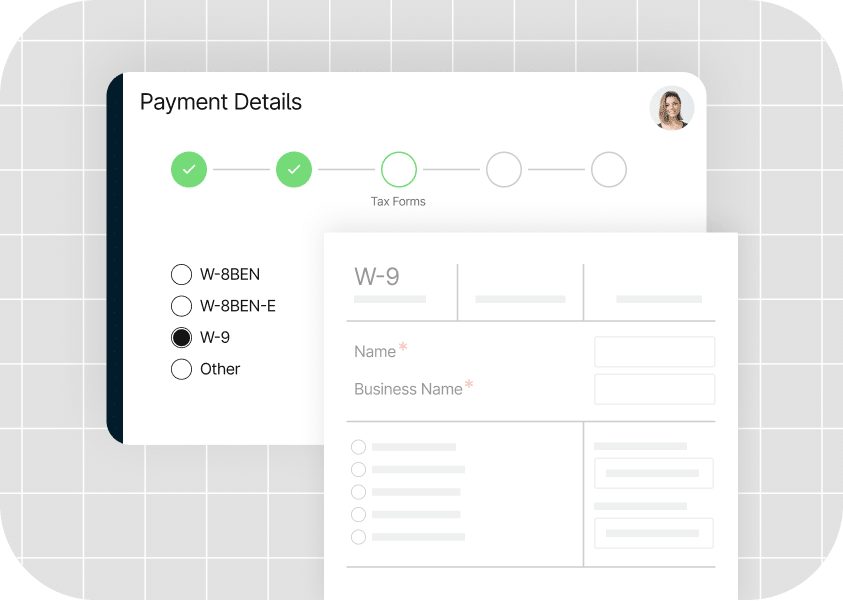Tackle Tax Compliance Like a Pro
Our automated tax compliance solutions give you confidence and efficiency as your business scales across borders.
Tax Compliance Features
Cut Tax Risks and Automate Your Filing Process
Collect and validate—without the stress. With global tax capabilities, you can confidently navigate complex regulations and simplify your year-end process.
Be Fully Compliant and Slash Tax Risks
Tipalti’s tax solution simplifies the compliance process and helps your company abide by CRA tax regulations. You can require all payees to provide their business number (BN) or social insurance number (SIN) as part of self-registration on the Tipalti portal. You can rest easy knowing your payables operation is always up-to-date with the latest tax laws.
Digitize Tax Form Collection and Validation for Ease of Use
Tipalti’s guided tax form wizard helps suppliers of US payers choose the correct form based on country and business structure. Once the correct tax form is selected, Tipalti digitizes documents and applies 1,000+ rules, to ensure the proper data has been provided. At year-end, Tipalti generates tax preparation reports and calculates any necessary withholdings.

Go Global With International Tax Capabilities
For non-US payers, local and VAT tax ID collection is available. For European countries, we also support document collection so payees can provide additional information when needed and self-billing invoices where payees must approve invoices before payments can be processed.
- Collecting and validating local tax IDs in 60+ countries, including business numbers (BNs) and social insurance numbers (SINs) in Canada*
- Built-in tax engine validates against 3,000+ rules to help prevent ID errors and issues
*Supported countries are: Argentina, Australia, Austria, Azerbaijan, Brazil, Bulgaria, Canada, Chile, China, Colombia, Costa Rica, Croatia, Cyprus, Czech Republic, Denmark, Dominican Republic, Estonia, Finland, France, Germany, Greece, Honduras, Hong Kong, Hungary, India, Indonesia, Ireland, Israel, Italy, Japan, Kuwait, Latvia, Lithuania, Luxembourg, Malta, Malaysia, Mexico, Netherlands, New Zealand, Paraguay, Peru, Philippines, Poland, Portugal, Romania, Russia, Saudi Arabia, Singapore, Slovakia, Slovenia, South Africa, South Korea, Spain, Sweden, Switzerland, Thailand, UAE, Ukraine, United Kingdom, Uruguay, Vietnam.
Simplify Your Year-End Tax Filing
Save time and improve efficiency with our e-filing integrations. Give your team the tools they need to avoid the end-of-year crunch and get your tax filings completed and out the door before deadlines.
Integrations
Pre-Built ERP Connections to Extend Automated Workflows
Easily extend and simplify your workflows with pre-built integrations and powerful APIs for your ERPs, accounting systems, performance marketing platforms, HRIS, SSO, Slack, credit cards, and more.
Customer Stories
Don’t just take our word for it,
see what our customers are saying
How It Works
Up and Running in Weeks, Not Months
Collaborative customer support with customized onboarding to get you operational quickly
Step 1
Plan
Kickstart your success with a comprehensive setup call that reviews your manual AP workflow, outlines the onboarding plan, validates technical configurations, and prepares for training.
Step 2
Configure
Tipalti’s implementation experts set up your hosted portal, create sample payment files, configure payment options and email integrations, and establish ERP integrations using our pre-built solutions.
Step 3
Deploy
In-depth training for AP staff on the Tipalti Hub and the end-to-end AP automation functionalities, ensuring thorough knowledge transfer to turbocharge your successful launch.
Step 4
Adopt
Support user adoption and change management during launch while guiding suppliers through onboarding. Once set, you’ll be ready to execute your first payment run and officially launch Tipalti.
Step 5
Optimize
Continued technical support by phone and email. Tipalti customer success team learns your goals and offers solutions to reach them.
Platform Features
Work smarter, not harder
With AI and machine learning capabilities, an intuitive UX, and quick and easy global payments, you can drive unprecedented efficiency.
Awards
#1 award-winning finance automation solution

2025 Inc. 5000 List of America’s Fastest-Growing Companies
Awarded to Tipalti for the 8th consecutive year

2024 Deloitte Technology
Fast 500
Awarded to Tipalti for the 7th consecutive year

2025 CNBC World’s Top Fintech Company
Digital Business Solutions Category

Spend Matters’ 50 to Know 2024
Awarded to Tipalti for the 5th consecutive year
Get Up and Running in Weeks, Not Months
Book a demo to get started today and take control of your finance operations with Tipalti.
Tax Compliance FAQs
What types of tax obligations stem from payments to suppliers, contractors and other types of payees?
Payments to suppliers, contractors, and other types of payees or partnerships come with a variety of tax obligations, which differ depending on factors like the payee’s status, the nature of the services, and the country in which the transactions take place.
The following are some of the key tax obligations that businesses may need to consider when making payments to these entities:
Withholding Taxes
For suppliers and contractors, companies may be required to withhold a portion for tax purposes. Tax codes will differ based on the region and tax compliance processes.
- Independent contractors: For domestic workers, organizations may have to report payments for services provided. However, direct withholding is not typically required.
- Non-resident withholding tax: Payments to foreign contractors may trigger withholding tax obligations from that region’s tax department. This process ensures that taxes are collected from non-residents who earn income within a country.
Goods and Services Tax (GST), Sales Tax, and Value-Added Tax
When making payments to suppliers, companies may be obligated to pay or collect consumption tax. Regulations include:
- Sales Tax: For U.S. businesses, sales tax must be paid on the purchase of certain goods and services. Typically at the point of sale.
- GST/HST: In Canada, companies may be required to pay the Goods and Services Tax.
- VAT: In Europe and other regions, businesses may need to charge VAT on sales and remit it later on.
Cross-Border Payments and Transfer Pricing
Payments to foreign suppliers may trigger cross-border tax obligations. This trigger is especially the case concerning transfer pricing rules.
- Transfer pricing: Payments between related entities in different countries must adhere to certain principles to prevent profit shifting. Transfer pricing ensures appropriate taxation in each tax jurisdiction, keeping tax authorities happy.
- Tax treaties: Double taxation treaties between two countries may reduce withholding tax rates or clarify which country has taxing rights over specific payments.
Other Forms of Tax
- Employment tax
- Corporate income tax deductibility
- Provincial or state tax
- Excise and custom duties
- Indirect tax and use tax
What are the benefits of automated tax compliance?
Automated tax compliance offers several benefits. It streamlines the complex and time-consuming tasks involved in complying with tax regulations. Below are just a few:
Reduced Errors and Increased Accuracy
Automated tax SaaS helps eliminate spreadsheets and manual data entry. The software can also automatically update tax rates and rules more accurately to validate tax data.
Time and Cost Efficiency
Automation speeds up repetitive tasks and reduces labor costs. Cloud-based tax technology also enables businesses to manage an increasing volume of transactions without spending more money.
Simplified Compliance
For organizations that operate in multiple regions, tax software can manage the various local, state, and international laws for when you file returns. It will automatically apply the correct rates depending on the jurisdiction, reducing complexity.
Improved Reporting
Automated tax compliance software can generate real-time reports, providing greater insights into tax liabilities, payment statuses, and upcoming deadlines. All tax-related data is centralized and easily accessible. Some programs might also offer certificate management for exemption certificates.
Additional Benefits
- Enhanced regulatory compliance
- Reduced risk of penalties
- Seamless integration with ERPs and financial systems
- Better cash flow management
- Customization and scalability
How does Tipalti handle tax form validation and verification?
Tipalti handles tax form validation and verification by automating the collection, validation, and verification process for various tax forms. The validation ensures that the data provided by payees is compliant with tax regulations.
Here’s how:
Real-Time Validation
Tipalti validates the data provided by payees in real time. As payees fill out their tax forms, the system checks the data for completeness and correctness, reducing the chances of missing or inaccurate details that could lead to compliance issues.
Automated Tax Form Collection
The system collects the necessary tax forms from suppliers and other payees during onboarding. Based on the payee’s residency and tax classification, Tipalti determines the type of tax form they will need to complete. The system will also auto-code GST/HST/PST/QST codes, including self-billing and PO matching tasks.
Error Notifications
It automatically flags the issue if the system detects invalid or incomplete data, such as incorrect TINs or missing information on a tax form. These notifications prompt the payee or the AP team to correct the information before payment processing.
Withholding Tax Calculations
Based on the verified tax data, Tipalti will automatically calculate the applicable withholding tax rate for both Canadian and non-Canadian payees. For payees, this includes applying the correct rates for reporting. Tipalti applies withholding taxes for international payees based on the relevant tax treaties.
Additional Ways Tipalti Handles Tax Validation
- Securely store all tax forms and verification data
- Comprehensive audit trail of all tax form submissions
- Any required withholding taxes are applied according to any local tax guidelines
Recommendations










